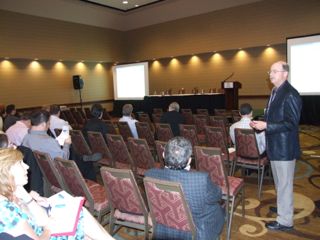
 June 12, 2013 – Steve Hopwood, account manager for fenestration products at Natural Resources Canada, told Fenestration Canada members about changes to the Energy Star
June 12, 2013 – Steve Hopwood, account manager for fenestration products at Natural Resources Canada, told Fenestration Canada members about changes to the Energy Star
program at the FC Annual General Meeting in St. John's, N.L., on May
31. Upcoming changes include a new climate map, a revised website and
stricter criteria. He also discussed the results of market studies the
Energy Star program conducted in Ontario.
 June 12, 2013 – Steve Hopwood, account manager for fenestration products at Natural Resources Canada, told Fenestration Canada members about changes to the Energy Star program at the FC Annual General Meeting in St. John's, N.L., on May 31. Upcoming changes include a new climate map, a revised website and stricter criteria. He also discussed the results of market studies the Energy Star program conducted in Ontario.
June 12, 2013 – Steve Hopwood, account manager for fenestration products at Natural Resources Canada, told Fenestration Canada members about changes to the Energy Star program at the FC Annual General Meeting in St. John's, N.L., on May 31. Upcoming changes include a new climate map, a revised website and stricter criteria. He also discussed the results of market studies the Energy Star program conducted in Ontario.
A new Energy Star map is due to be launched in February of 2015. The map will reduce the number of climate zones in Canada from four to three, using heating day values harmonized with the National Building Code. The map is similar to the proposed one shown at Win-Door last fall, but with some minor changes.
Energy Star will be tightening its criteria for many locations. The program will eliminate the U-factor cap for the ER compliance path. Sliding glass doors will have to meet a minimum ER value even if they are on the U-factor path. All fenestration products will have to meet NAFS standards for air/water ingress or be removed from the main online listings and placed in the Archived category. Requirements for tubular skylights have also been added.
Energy Star launched an email campaign asking fabricators to update their Energy Star listed models. Hopwood reported a slight reduction in the in the participation of dealers and fabricators, but an overall increase in the numbers of models listed. Fabricators who dropped out of Energy Star often listed testing costs as the reason.
A pilot market research study in Ontario found that most Energy Star products sold for low-rise residential were in the middle of the range for U-factor rating. Products for storefront and multi-unit residential use tended to be in the lower ranges.
Hopwood says Energy Star wants to encourage higher installation standards, but has not yet formed a strategy to do so. His office is looking for some way to work with the Fenestration Installation Technician certification program. Problems still exist with installers taking Energy Star labels off. Labeling and installation guidelines are to be updated this year.
Hopwood warned that major changes would be coming to the Energy Star website as part of a federal government initiative to reduce the number of Canadian government websites from over 1,000 to six. No details of the change are known yet.
Energy Star is planning upgrades to its data entry tools to streamline the process for participants. Hopwood described plans to reduce number of columns on the data entry page, integrate French and English into one dynamic
document, implement new error-checking protocols and to migrate the platform to Excel 2007 or higher. Future versions of the software will include a data conversion tool that takes National Fenestration Rating Council data and migrates it into NRCan's format.
Related links
www.oee.nrcan.gc.ca/equipment/windows-doors
www.fenestrationcanada.ca
Print this page
Leave a Reply